Disadvantage and sixth form subject choices
Back
This piece was initially published on FFT Education Datalab's blog in April here by Natasha Plaister. Datalab are a team of education data analysts, using statistics to inform policymaking and school practices.
In this post, we’ll look at how the post-16 qualifications entered by disadvantaged students differ from their peers, and how far this can be explained by differences in attainment at Key Stage 4.
We’ll use data from the National Pupil Database on students who completed Key Stage 4 in 2018 and went on to complete Key Stage 5 in 2020.
Academic or vocational route?
First we’ll take a look at the route students taking during Key Stage 5. The chart below breaks these down into academic, applied general and technical qualifications.​[1] It also includes students who did not go on to complete any Level 3 qualifications within two years of completing KS4.

Disadvantaged pupils were less likely than their peers to complete any L3 qualification and less likely to choose an academic route – just 16% did so compared to 37% of their peers. However, the two groups are equally likely to choose applied generals (both 13%) and technical qualifications (both 5%).
This means that for those students who do complete Level 3 qualifications, applied general and technical qualifications are a much more common route for disadvantaged students than for their peers.
What about subject choice?
Now we’ll take a look at differences in subject choice at BTEC and A-Level, starting with BTECs.
The most popular BTEC in 2020 was business studies, which was studied by 26% of BTEC students. It was slightly more popular among disadvantaged BTEC students, 28% of whom chose the subject, than their peers, at 26%, a difference of two percentage points.
In the chart below, we show the difference in percentage points in the proportion of disadvantaged BTEC students and their peers entering each subject.
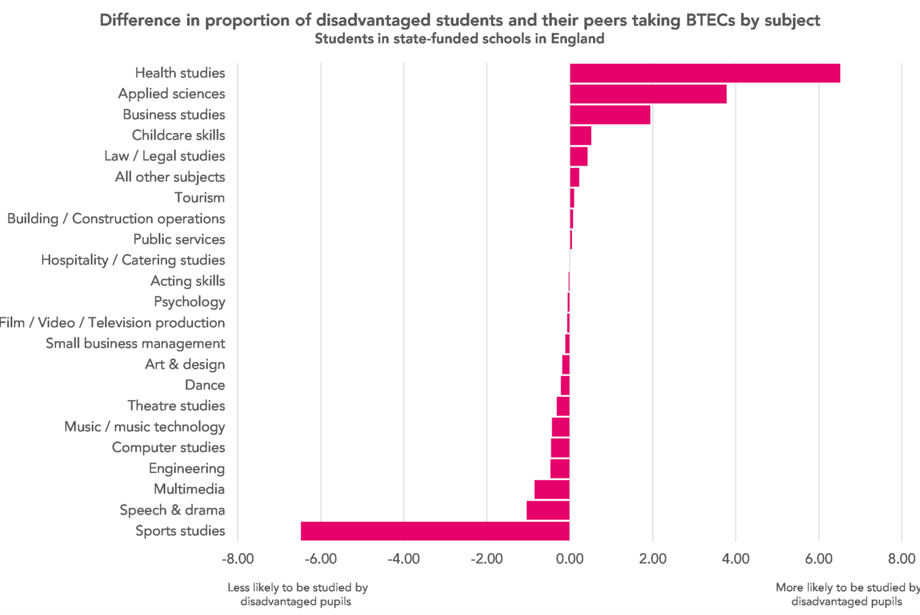
Disadvantaged students were more likely than their peers to take health studies and applied sciences, both of which can be used as pathways into nursing, and less likely to take sports studies. They were also more likely to take a BTEC in business studies, although, as we shall see, they were less likely than their peers to take an A-Level in business studies.
Although there were some differences in subject choice at BTECs, most subjects were more or less equally popular with disadvantaged BTEC students and their peers.
But when it comes to A-Levels, there were fairly large differences for quite a number of subjects.
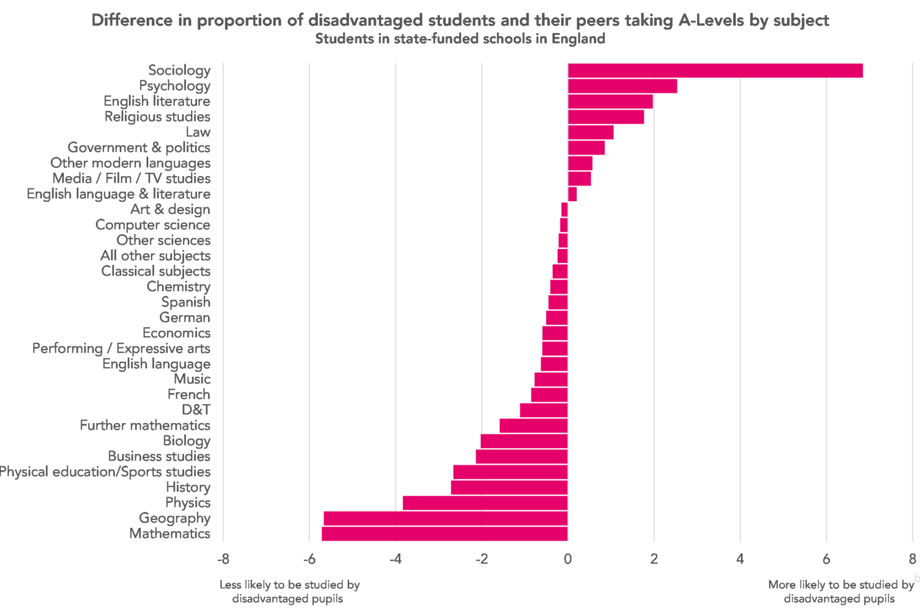
Disadvantaged students were more likely to study sociology and less likely to study maths, geography and physics. Other subjects, including art and design and computer studies, were more or less equally popular with disadvantaged pupils and their peers.
Prior attainment
Of course, some of the differences in subject choice can be explained by differences in prior attainment. Disadvantaged pupils do tend to have lower attainment at KS4 than their peers. This may be preventing them from choosing Key Stage 5 routes with higher entry requirements.
The chart below shows how the proportion of taking different routes at KS5 breaks down by prior attainment tier.​2
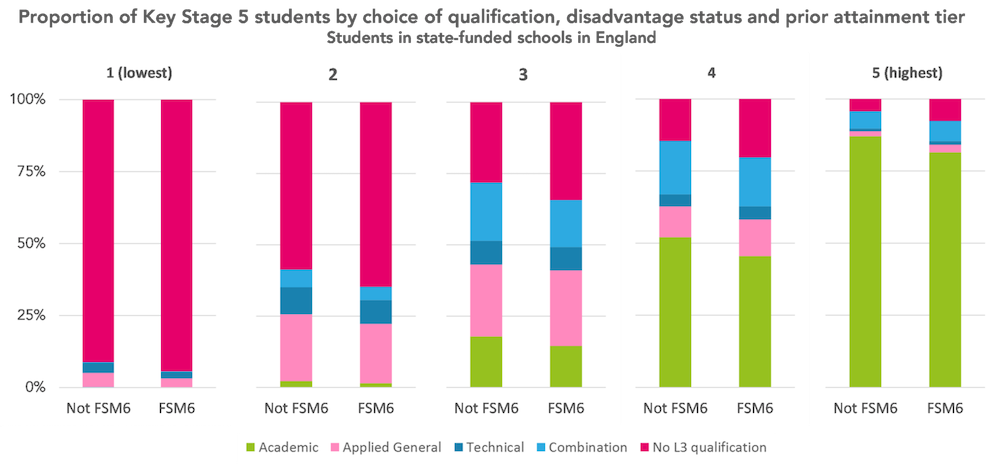
At every level of prior attainment, disadvantaged pupils are less likely to complete a Level 3 qualification and less likely to take an academic route. Even among the highest attainers, just 81% of disadvantaged students went down this route, compared to 87% of their peers. So prior attainment isn’t explaining all of the difference here.
A-Level subjects and prior attainment
Some A-Levels, in particular, have higher entry requirements than others, so differences in prior attainment may be driving different choices here too. Let’s take a look at which A-Level subjects are associated with the highest prior attainment.

Some of the subjects which are less popular with disadvantaged students – for example, physics and maths – are associated with high prior attainment, although this isn’t particularly true of subjects like geography and history.
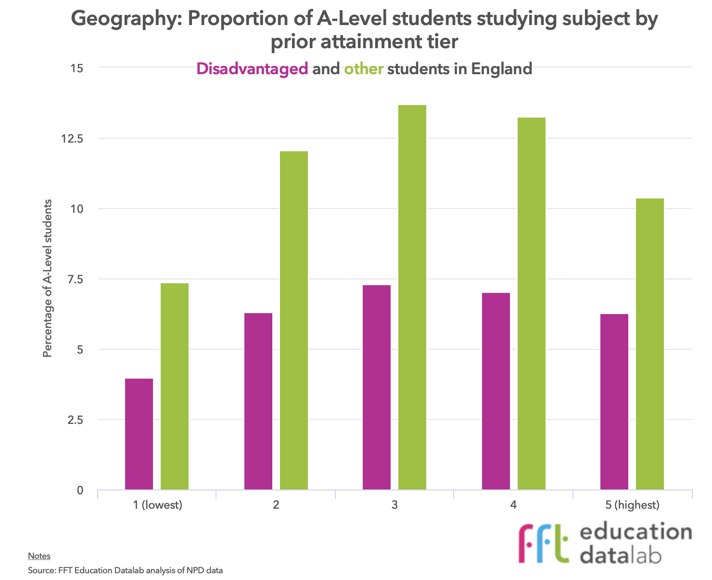
13.26%
Some subjects see a large difference regardless of prior attainment. Geography, music and history are all less popular with disadvantaged students at every level of prior attainment, while sociology is more popular.
Both biology and chemistry were more popular among high attaining A-Level students who are disadvantaged than with their peers. Nearly half (49%) of disadvantaged A-Level students in the highest quintile studied chemistry, compared to 41% of their peers. For biology, the figures are 43% and 38%.
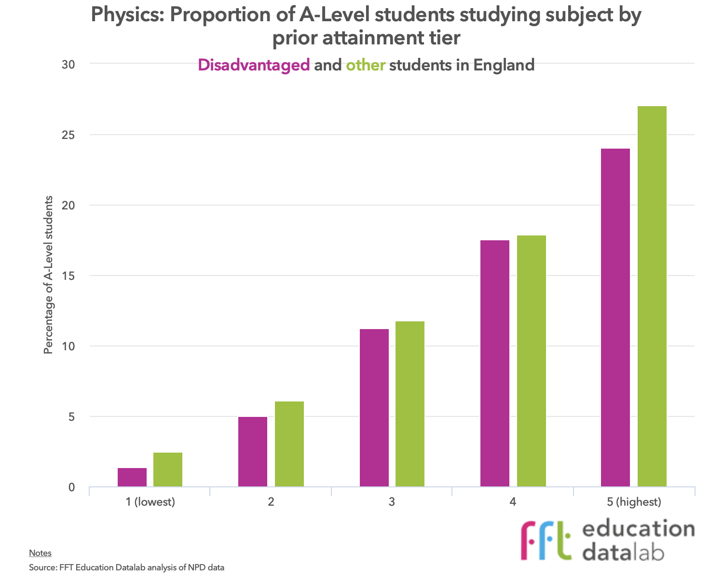
Perhaps surprisingly, this is not the case for physics, which was chosen by just 24% of the highest attaining disadvantaged A-Level students compared to 27% of their peers. This may be related to the entry requirements for medical degrees – which usually include biology and chemistry but not physics.
In conclusion
Disadvantaged students are less likely than their peers to choose an academic route of post-16 study, and less likely to complete a Level 3 qualification.
They are also less likely to choose some subjects than their peers – and this is not entirely explained by differences in prior attainment.
Notes
[1]: Here we’ve defined academic qualifications as A-Levels, Pre-U and IB courses, applied generals as BTECs and OCR technical certificates and any other technical certificate as a technical qualification.
[2]We split pupils into five prior attainment groups based on their Attainment 8 scores at the end of Key Stage 4.
Natasha Plaister is a statistician at the Datalab.

